The May Daring Bakers’ challenge was hosted by Linda of make life sweeter! and Courtney of Coco Cooks. They chose Apple Strudel from the recipe book Kaffeehaus: Exquisite Desserts from the Classic Cafés of Vienna, Budapest and Prague by Rick Rodgers.
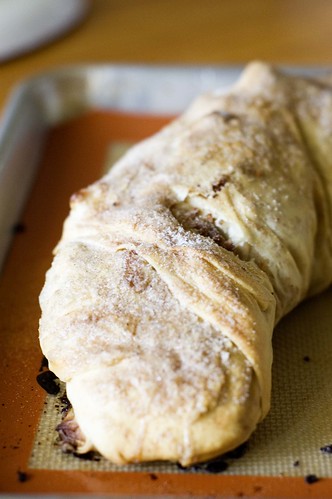
I have to admit, when I found out what this month's Daring Bakers challenge was, I was a little disappointed. Apple Strudel? Huh? Sure, I've heard of it, but after reading through the recipe I realized I've never even had real apple strudel. I wasn't quite sure what was going to be so challenging about it until I realized it was the dough that was the challenge - essentially, we'd be making phyllo dough! My heart sank. I was instantly turned off and was dreading this challenge. It just didn't sound like fun, or like the end result would be very yummy. I contemplated opting out, and almost did in fact.
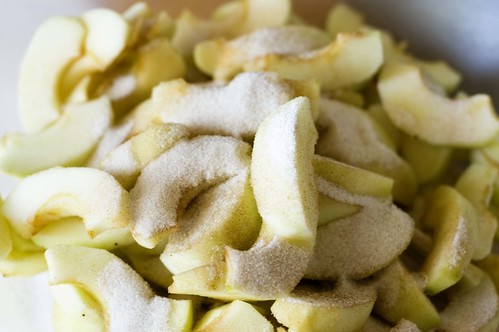
However, the nature of being in a group like the Daring Bakers is to challenge yourself and to try things you might never have otherwise considered. After contemplating this, I had a change of heart and decided to give it a go.
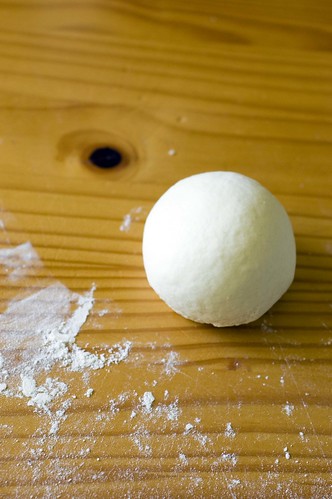
from this...
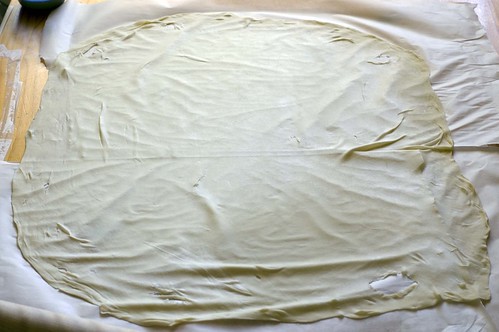
to this!
Everything seemed fairly simple and I didn't really need to buy any ingredients except the apples. One thing that threw me was that the dough is supposed to be rolled out on a large piece of cloth - about 2 feet by 3 feet - and I didn't have anything that large and of the right material to use. The dough is to be paper thin and the cloth helps you roll the entire thing up once you add the filling.
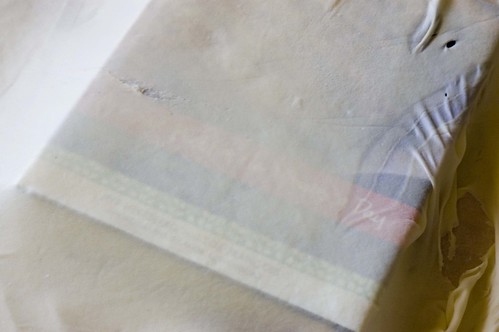
almost thin enough to read through
I certainly didn't want to go buy anything since I already was positive I'd never be making this recipe again (hint: I was wrong!) so I ended up taping down a few sheets of parchment paper instead. That was a total failure! Here's a little tidbit for ya - tape doesn't stick to parchment for longer than, oh, about 2 minutes (and about 10 seconds if you're attempting to roll anything out on it!). Of course, I didn't discover this until I was already rolling out the dough and the pieces of parchment started sliding all around underneath. Luckily, this dough is very easy to work with and I didn't have any problems with it sticking despite my parchment problems.

However, the nature of being in a group like the Daring Bakers is to challenge yourself and to try things you might never have otherwise considered. After contemplating this, I had a change of heart and decided to give it a go.

from this...

to this!
Everything seemed fairly simple and I didn't really need to buy any ingredients except the apples. One thing that threw me was that the dough is supposed to be rolled out on a large piece of cloth - about 2 feet by 3 feet - and I didn't have anything that large and of the right material to use. The dough is to be paper thin and the cloth helps you roll the entire thing up once you add the filling.

almost thin enough to read through
I certainly didn't want to go buy anything since I already was positive I'd never be making this recipe again (hint: I was wrong!) so I ended up taping down a few sheets of parchment paper instead. That was a total failure! Here's a little tidbit for ya - tape doesn't stick to parchment for longer than, oh, about 2 minutes (and about 10 seconds if you're attempting to roll anything out on it!). Of course, I didn't discover this until I was already rolling out the dough and the pieces of parchment started sliding all around underneath. Luckily, this dough is very easy to work with and I didn't have any problems with it sticking despite my parchment problems.
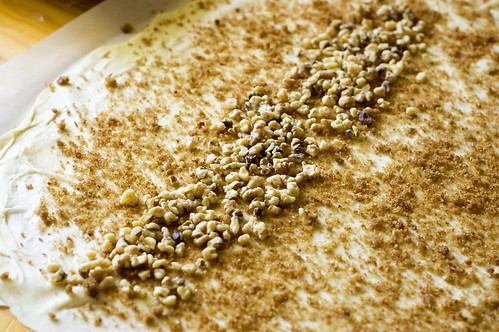
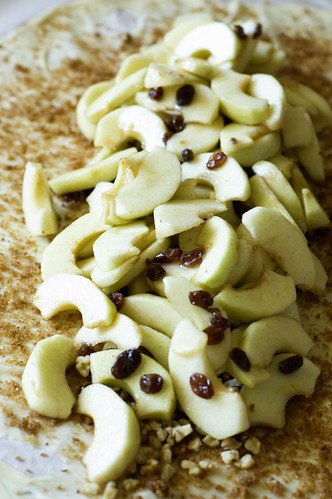
I was able to get my dough thin enough for my liking (probably could've done a better job if I'd had the cloth to use) without too many tears and the whole thing came together quite easily. The final product wasn't the prettiest looking creation, but I was totally surprised when I took a bite - it was delicious!
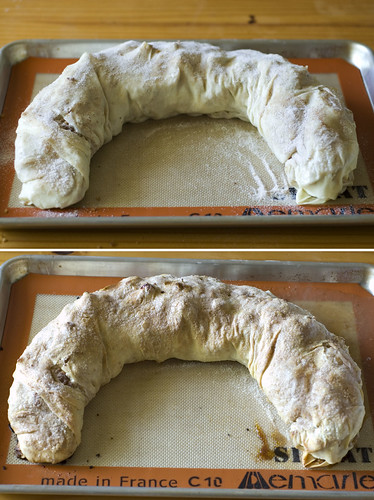
pre and post bake
The dough was wonderfully flaky and crisp and surprisingly had a great flavor to it. I would've preferred more crust to apple ratio, but all in all, I was totally surprised by the end result. I felt bad for wanting to brush this recipe off in the first place and was so happy I didn't! I had followed the recipe exactly since I was feeling very uninspired and wasn't even sure of what the end result would be like, but after tasting it, wheels were already turning and thinking of other ways I can use this dough (this, for example). It really is THAT good.
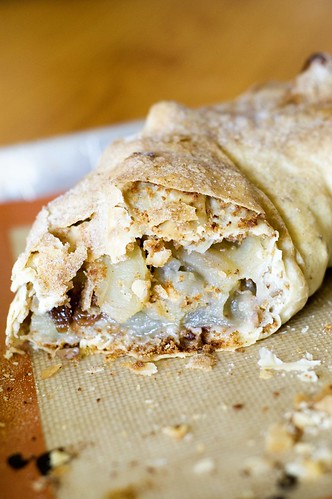
I can honestly say, I will make this recipe again for sure, and when I do, I'll even take the extra step of finding a large piece of cloth I can roll the dough out on as I know it will help produce an even better result.

pre and post bake
The dough was wonderfully flaky and crisp and surprisingly had a great flavor to it. I would've preferred more crust to apple ratio, but all in all, I was totally surprised by the end result. I felt bad for wanting to brush this recipe off in the first place and was so happy I didn't! I had followed the recipe exactly since I was feeling very uninspired and wasn't even sure of what the end result would be like, but after tasting it, wheels were already turning and thinking of other ways I can use this dough (this, for example). It really is THAT good.

I can honestly say, I will make this recipe again for sure, and when I do, I'll even take the extra step of finding a large piece of cloth I can roll the dough out on as I know it will help produce an even better result.
A big thanks to Courtney and Linda! As apprehensive as I was in the beginning, I'm very pleased with this recipe and for the challenge!
Preparation time
Total: 2 hours 15 minutes – 3 hours 30 minutes
15-20 min to make dough
30-90 min to let dough rest/to prepare the filling
20-30 min to roll out and stretch dough
10 min to fill and roll dough
30 min to bake
30 min to cool
Apple Strudel
from “Kaffeehaus – Exquisite Desserts from the Classic Cafés of Vienna, Budapest and Prague” by Rick Rodgers
2 tablespoons (30 ml) golden rum
3 tablespoons (45 ml) raisins
1/4 teaspoon ground cinnamon
1/3 cup plus 1 tablespoon (80 g) sugar
1/2 cup (1 stick / 115 g) unsalted butter, melted, divided
1 1/2 cups (350 ml) fresh bread crumbs
strudel dough (recipe below)
1/2 cup (120 ml, about 60 g) coarsely chopped walnuts
2 pounds (900 g) tart cooking apples, peeled, cored and cut into ¼ inch-thick slices (use apples that hold their shape during baking)
1. Mix the rum and raisins in a bowl. Mix the cinnamon and sugar in another bowl.
2. Heat 3 tablespoons of the butter in a large skillet over medium-high. Add the breadcrumbs and cook whilst stirring until golden and toasted. This will take about 3 minutes. Let it cool completely.
3. Put the rack in the upper third of the oven and preheat the oven to 400°F (200°C). Line a large baking sheet with baking paper (parchment paper). Make the strudel dough as described below. Spread about 3 tablespoons of the remaining melted butter over the dough using your hands (a bristle brush could tear the dough, you could use a special feather pastry brush instead of your hands). Sprinkle the buttered dough with the bread crumbs. Spread the walnuts about 3 inches (8 cm) from the short edge of the dough in a 6-inch-(15cm)-wide strip. Mix the apples with the raisins (including the rum), and the cinnamon sugar. Spread the mixture over the walnuts.
4. Fold the short end of the dough onto the filling. Lift the tablecloth at the short end of the dough so that the strudel rolls onto itself. Transfer the strudel to the prepared baking sheet by lifting it. Curve it into a horseshoe to fit. Tuck the ends under the strudel. Brush the top with the remaining melted butter.
5. Bake the strudel for about 30 minutes or until it is deep golden brown. Cool for at least 30 minutes before slicing. Use a serrated knife and serve either warm or at room temperature. It is best on the day it is baked.
Strudel dough
from “Kaffeehaus – Exquisite Desserts from the Classic Cafés of Vienna, Budapest and Prague” by Rick Rodgers
1 1/3 cups (200 g) unbleached flour
1/8 teaspoon salt7 tablespoons (105 ml) water, plus more if needed
2 tablespoons (30 ml) vegetable oil, plus additional for coating the dough
1/2 teaspoon cider vinegar
1. Combine the flour and salt in a stand-mixer fitted with the paddle attachment. Mix the water, oil and vinegar in a measuring cup. Add the water/oil mixture to the flour with the mixer on low speed. You will get a soft dough. Make sure it is not too dry, add a little more water if necessary.Take the dough out of the mixer. Change to the dough hook. Put the dough ball back in the mixer. Let the dough knead on medium until you get a soft dough ball with a somewhat rough surface.
2. Take the dough out of the mixer and continue kneading by hand on an unfloured work surface. Knead for about 2 minutes. Pick up the dough and throw it down hard onto your working surface occasionally.Shape the dough into a ball and transfer it to a plate. Oil the top of the dough ball lightly. Cover the ball tightly with plastic wrap. Allow to stand for 30-90 minutes (longer is better).
3. It would be best if you have a work area that you can walk around on all sides like a 36 inch (90 cm) round table or a work surface of 23 x 38 inches (60 x 100 cm). Cover your working area with table cloth, dust it with flour and rub it into the fabric. Put your dough ball in the middle and roll it out as much as you can.Pick the dough up by holding it by an edge. This way the weight of the dough and gravity can help stretching it as it hangs. Using the back of your hands to gently stretch and pull the dough. You can use your forearms to support it.
4. The dough will become too large to hold. Put it on your work surface. Leave the thicker edge of the dough to hang over the edge of the table. Place your hands underneath the dough and stretch and pull the dough thinner using the backs of your hands. Stretch and pull the dough until it's about 2 feet (60 cm) wide and 3 feet (90 cm) long, it will be tissue-thin by this time. Cut away the thick dough around the edges with scissors. The dough is now ready to be filled.
Tips
- The tablecloth can be cotton or polyster
- Before pulling and stretching the dough, remove your jewelry from hands and wrists, and wear short-sleeves
- To make it easier to pull the dough, you can use your hip to secure the dough against the edge of the table
- Few small holes in the dough is not a problem as the dough will be rolled, making (most of) the holes invisible
Preparation time
Total: 2 hours 15 minutes – 3 hours 30 minutes
15-20 min to make dough
30-90 min to let dough rest/to prepare the filling
20-30 min to roll out and stretch dough
10 min to fill and roll dough
30 min to bake
30 min to cool
Apple Strudel
from “Kaffeehaus – Exquisite Desserts from the Classic Cafés of Vienna, Budapest and Prague” by Rick Rodgers
2 tablespoons (30 ml) golden rum
3 tablespoons (45 ml) raisins
1/4 teaspoon ground cinnamon
1/3 cup plus 1 tablespoon (80 g) sugar
1/2 cup (1 stick / 115 g) unsalted butter, melted, divided
1 1/2 cups (350 ml) fresh bread crumbs
strudel dough (recipe below)
1/2 cup (120 ml, about 60 g) coarsely chopped walnuts
2 pounds (900 g) tart cooking apples, peeled, cored and cut into ¼ inch-thick slices (use apples that hold their shape during baking)
1. Mix the rum and raisins in a bowl. Mix the cinnamon and sugar in another bowl.
2. Heat 3 tablespoons of the butter in a large skillet over medium-high. Add the breadcrumbs and cook whilst stirring until golden and toasted. This will take about 3 minutes. Let it cool completely.
3. Put the rack in the upper third of the oven and preheat the oven to 400°F (200°C). Line a large baking sheet with baking paper (parchment paper). Make the strudel dough as described below. Spread about 3 tablespoons of the remaining melted butter over the dough using your hands (a bristle brush could tear the dough, you could use a special feather pastry brush instead of your hands). Sprinkle the buttered dough with the bread crumbs. Spread the walnuts about 3 inches (8 cm) from the short edge of the dough in a 6-inch-(15cm)-wide strip. Mix the apples with the raisins (including the rum), and the cinnamon sugar. Spread the mixture over the walnuts.
4. Fold the short end of the dough onto the filling. Lift the tablecloth at the short end of the dough so that the strudel rolls onto itself. Transfer the strudel to the prepared baking sheet by lifting it. Curve it into a horseshoe to fit. Tuck the ends under the strudel. Brush the top with the remaining melted butter.
5. Bake the strudel for about 30 minutes or until it is deep golden brown. Cool for at least 30 minutes before slicing. Use a serrated knife and serve either warm or at room temperature. It is best on the day it is baked.
Strudel dough
from “Kaffeehaus – Exquisite Desserts from the Classic Cafés of Vienna, Budapest and Prague” by Rick Rodgers
1 1/3 cups (200 g) unbleached flour
1/8 teaspoon salt7 tablespoons (105 ml) water, plus more if needed
2 tablespoons (30 ml) vegetable oil, plus additional for coating the dough
1/2 teaspoon cider vinegar
1. Combine the flour and salt in a stand-mixer fitted with the paddle attachment. Mix the water, oil and vinegar in a measuring cup. Add the water/oil mixture to the flour with the mixer on low speed. You will get a soft dough. Make sure it is not too dry, add a little more water if necessary.Take the dough out of the mixer. Change to the dough hook. Put the dough ball back in the mixer. Let the dough knead on medium until you get a soft dough ball with a somewhat rough surface.
2. Take the dough out of the mixer and continue kneading by hand on an unfloured work surface. Knead for about 2 minutes. Pick up the dough and throw it down hard onto your working surface occasionally.Shape the dough into a ball and transfer it to a plate. Oil the top of the dough ball lightly. Cover the ball tightly with plastic wrap. Allow to stand for 30-90 minutes (longer is better).
3. It would be best if you have a work area that you can walk around on all sides like a 36 inch (90 cm) round table or a work surface of 23 x 38 inches (60 x 100 cm). Cover your working area with table cloth, dust it with flour and rub it into the fabric. Put your dough ball in the middle and roll it out as much as you can.Pick the dough up by holding it by an edge. This way the weight of the dough and gravity can help stretching it as it hangs. Using the back of your hands to gently stretch and pull the dough. You can use your forearms to support it.
4. The dough will become too large to hold. Put it on your work surface. Leave the thicker edge of the dough to hang over the edge of the table. Place your hands underneath the dough and stretch and pull the dough thinner using the backs of your hands. Stretch and pull the dough until it's about 2 feet (60 cm) wide and 3 feet (90 cm) long, it will be tissue-thin by this time. Cut away the thick dough around the edges with scissors. The dough is now ready to be filled.
Tips
- The tablecloth can be cotton or polyster
- Before pulling and stretching the dough, remove your jewelry from hands and wrists, and wear short-sleeves
- To make it easier to pull the dough, you can use your hip to secure the dough against the edge of the table
- Few small holes in the dough is not a problem as the dough will be rolled, making (most of) the holes invisible


Mmmm...looks totally gorgeous and delicious! YUM!
ReplyDeleteWhat a beautiful strudel! Very well done!
ReplyDeleteCheers,
Rosa
the streched dough looks great. great job!
ReplyDeleteGORGEOUS strudel! Your dough and photos are spectacular! I'm in awe :)
ReplyDeletei didn't use a table cloth either but i didn't get my dough to stretch as required. in the end, it still worked! awesome job. your photos are amazing!!
ReplyDeleteBeautiful photos! Your strudel looks fantastic!
ReplyDeleteYour strudel is gorgeous! Great job on this month's challenge!
ReplyDeleteGreat job! That does look wonderfully crisp. Yum!
ReplyDeleteYour strudel turned out so gorgeous!
ReplyDeleteThat's a remarkably thin dough...with a fine looking strudel to boot! You should try your own phyllo...similar process.
ReplyDelete